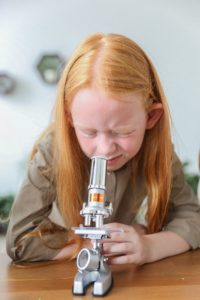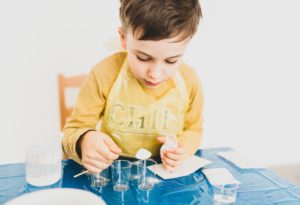STEM has left the building
For a long time, advocates of STEM education have worked to bring STEM learning closer to students’ lives outside of school. This year, though, COVID has made STEM learning a part of students’ lives outside of school in ways nobody ever imagined or wanted. The pandemic has forcibly ejected STEM from the traditional in-building school environment and strewn it about in a great blurry mess spread out variably and amorphously among the home, Zoom sessions, mask-, distance-, and time-limited classroom settings, and anywhere else in the natural or built world that students and their families can turn into sites of learning. Educators are managing the mess to the greatest of their abilities, and the resources and strategies that have been shared across the K-12 world both in general and in relation to STEM are voluminous.
Blurring the picture
 Even so, much of the job of sustaining STEM learning has of necessity fallen to families. The imperative to conduct STEM education at home has blurred many otherwise defined features of home life for parents and children, casting them in a new teacher-student relationship with little guidance in how to make it all work in a home that’s been converted into a part-time classroom. Though stressful and disruptive, this blurriness can also open teacher-parents and student-children to new possibilities for growth and learning in both academic and personal realms. At-home STEM education can in fact become a vehicle for promoting connectedness and resilience among family members, a boon for all in a time when tragedy and hardship have touched everyone.
Even so, much of the job of sustaining STEM learning has of necessity fallen to families. The imperative to conduct STEM education at home has blurred many otherwise defined features of home life for parents and children, casting them in a new teacher-student relationship with little guidance in how to make it all work in a home that’s been converted into a part-time classroom. Though stressful and disruptive, this blurriness can also open teacher-parents and student-children to new possibilities for growth and learning in both academic and personal realms. At-home STEM education can in fact become a vehicle for promoting connectedness and resilience among family members, a boon for all in a time when tragedy and hardship have touched everyone.
What we’ve lost
Uprooting STEM from the school building comes with many kinds of loss. The school-centered learning environment features carefully designed spaces set up with technical equipment and materials that are impossible to replicate in the home. STEM teachers bring advanced knowledge to the classroom that parents are hard-pressed to provide themselves. And losing access to other members of class during STEM activities really hurts. It cuts students off from the collaborative learning that fuels so much of the growth in knowledge, interest, and connectedness to their peers that the classroom environment provides. And these are just the headline losses; many people would have other items of their own to add.
Lost ground is hard to recover
 Transplanting STEM education into the home, in full or in part, yields a crop of potential challenges to learning. The gravest challenge would be the presence of infection in the student’s home. Isolation of anyone in a household disrupts and distorts routine or equilibrium in a family’s life. The best case is worry and tension, and worse cases span a spectrum of harms and losses that are easily imagined. As noted, replacing a teacher’s technical knowledge is hard. Many more parents are able to stand in as math or language arts teachers than as chemistry or physics teachers, quite apart from not having at-home laboratory equivalents available. And resources in the neighborhood that might step into the breach — community centers, afterschool organizations, libraries — face their own pandemic-related problems: limited in-person service capacity, reduced or lost funding, shortage of staff, and so on.
Transplanting STEM education into the home, in full or in part, yields a crop of potential challenges to learning. The gravest challenge would be the presence of infection in the student’s home. Isolation of anyone in a household disrupts and distorts routine or equilibrium in a family’s life. The best case is worry and tension, and worse cases span a spectrum of harms and losses that are easily imagined. As noted, replacing a teacher’s technical knowledge is hard. Many more parents are able to stand in as math or language arts teachers than as chemistry or physics teachers, quite apart from not having at-home laboratory equivalents available. And resources in the neighborhood that might step into the breach — community centers, afterschool organizations, libraries — face their own pandemic-related problems: limited in-person service capacity, reduced or lost funding, shortage of staff, and so on.
Digital divide headwinds
And of course, a great digital divide opens up dire inequities in prospects for at-home STEM learning. Internet access and computer equipment are distributed in widely varying levels among American households. To state the obvious, students who access Wi-Fi networks on a smart phone in the parking lot of the local public library learn differently from students who do so from a laptop on a desk in their own rooms. Even under the best case — with robust internet access and ample computing power — family members all must struggle with new roles and new responsibilities and new challenges in making at-home STEM learning work at all.
New opportunities to be found
The blurring of roles associated with at-home STEM education, however, can be liberating and generative, too. For example, getting a question wrong or failing in some way in front of peers in the classroom can register more painfully on children than the same experience at home with a parent. In fact, the different affective environment of the home can enable learning – and connection – at a different, perhaps deeper, level than what happens at school. Because the parent-child relationship encompasses such a wider range of social, emotional experiences than the teacher-student relationship, a child’s learning experience at home can accommodate a greater degree of social-emotional content. And it turns out that models of STEM learning and social-emotional learning (SEL) can mutually reinforce lessons drawn from both realms.
How to make the most of at-home STEM
 The Partnerships in Education and Resilience (PEAR) Institute at the McLean Hospital in suburban Boston supports diverse research programs in social-emotional learning. One thread of the research agenda addresses STEM learning through a multifaceted assessment framework that blends both STEM and SEL principles and practices. A “whole-child” model of psychological balance, the PEAR framework rests on four pillars of learning that can serve as a de facto checklist for families to use in their own at-home STEM learning activities. Not only do the four pillars encompass desiderata for STEM learning, they also open up space for parents to mesh STEM learning with support for childrens’ social-emotional well-being. In this way, at-home STEM learning can also serve as a bulwark against harms children might be suffering from pandemic-related stress and loss.
The Partnerships in Education and Resilience (PEAR) Institute at the McLean Hospital in suburban Boston supports diverse research programs in social-emotional learning. One thread of the research agenda addresses STEM learning through a multifaceted assessment framework that blends both STEM and SEL principles and practices. A “whole-child” model of psychological balance, the PEAR framework rests on four pillars of learning that can serve as a de facto checklist for families to use in their own at-home STEM learning activities. Not only do the four pillars encompass desiderata for STEM learning, they also open up space for parents to mesh STEM learning with support for childrens’ social-emotional well-being. In this way, at-home STEM learning can also serve as a bulwark against harms children might be suffering from pandemic-related stress and loss.
The PEAR Institute model has cross-cutting components, applicable to both STEM and SEL activities. They can be summarized as follows, per a presentation by PEAR Director Gil Noam:
- Active engagement – hands-on, kinetic experience with learning that moves students’ bodies.
- Assertiveness – expression of individual experiences and thoughts in students’ own, authentic voices.
- Belonging – learning and activity undertaken in collaboration and informed by interdependence and shared purpose.
- Reflection – space and time dedicated to making meaning of experience and integrating it into a student’s identity.
All four of these items describe features of both effective STEM education as well as positive social-emotional development. In effect, parent-teachers who can incorporate these components into at-home STEM activities will be fostering both substantive learning in their student-child as well as psychological balance in their child-student. Moreover, the shared learning experience will be enriching and strengthen connectedness between parent and child along the way. Exactly the blurring of all these roles – parent-teacher, child-student – serves to enable learning and growth to occur at the same time across both STEM and SEL modalities.
At least it’s something we can do
 Indeed, the byplay of learning across these modalities can feed reservoirs of resilience in children. Experiencing learning and growth within an emotional landscape of balance and connectedness can inoculate children against damage in social, academic, and developmental realms that could otherwise result from the loss of in-school time during the pandemic. To be sure, daily life during COVID has often been a bewildering blur. But seen from a certain angle, this blurriness can reveal feasible, if challenging, ways to make something constructive out of a time of extreme difficulty and general awful-ness.
Indeed, the byplay of learning across these modalities can feed reservoirs of resilience in children. Experiencing learning and growth within an emotional landscape of balance and connectedness can inoculate children against damage in social, academic, and developmental realms that could otherwise result from the loss of in-school time during the pandemic. To be sure, daily life during COVID has often been a bewildering blur. But seen from a certain angle, this blurriness can reveal feasible, if challenging, ways to make something constructive out of a time of extreme difficulty and general awful-ness.
For breakfast, I had cereal with fruit and some grapefruit juice. Followed by three homemade gingerbread cookies.
Author: @ericiversen
